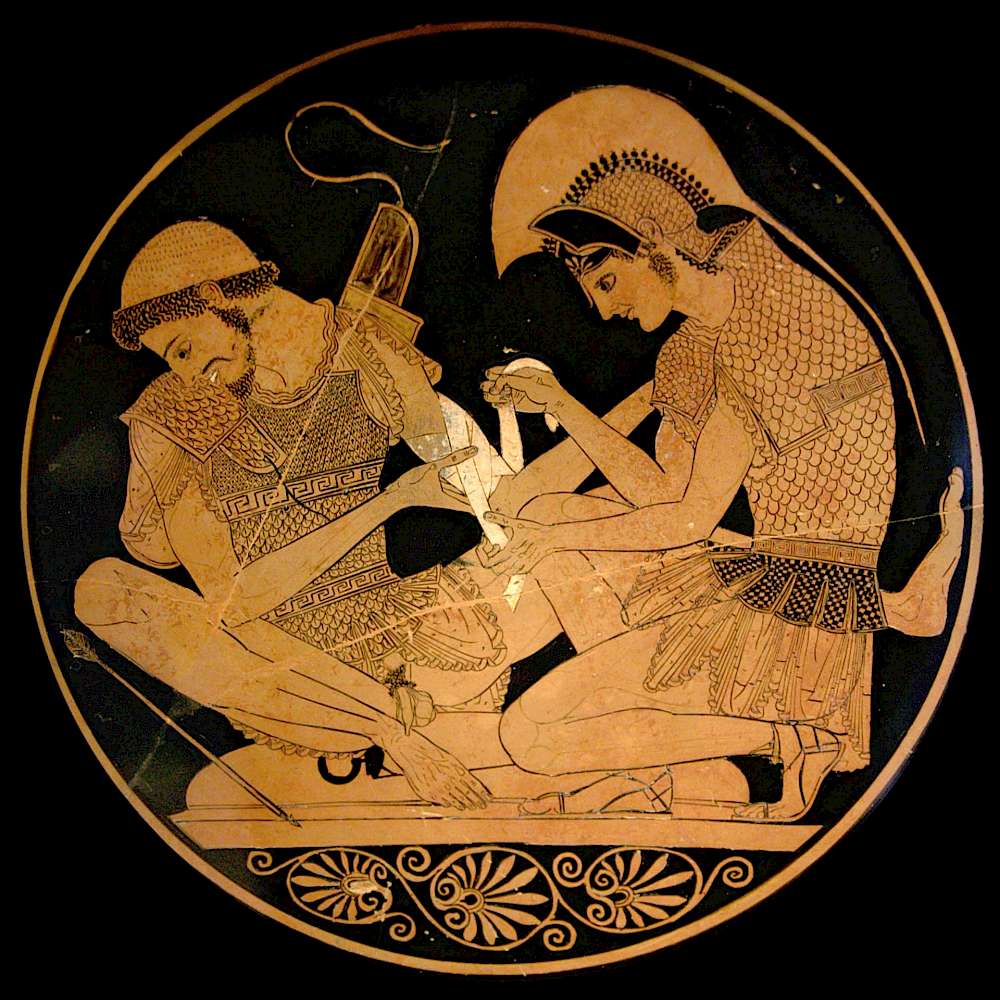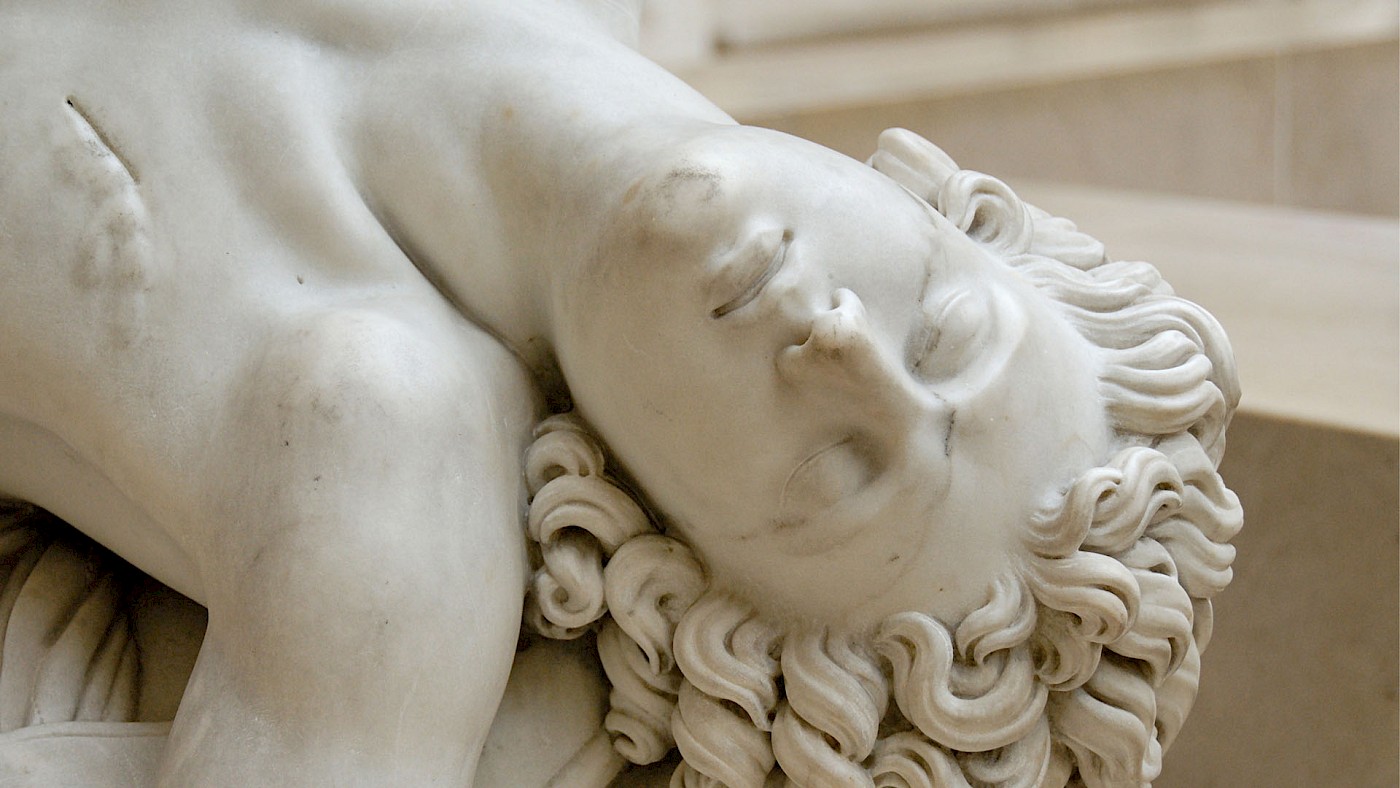Virgil’s epic poem the Aeneid traces the flight of the Trojan noble Aeneas from the ashes of Troy to the shores of Italy where he and his followers wage war against the peninsula’s natives. Nisus and Euryalus are a pair of Trojan soldiers and refugees who follow Aeneas in his search for a new home. Euryalus, the younger of the two, is described as “the most handsome” of the Trojans, while Nisus is hailed as a “tenacious warrior” (Aeneid 9.235-240; transl. Mandelbaum).
Virgil introduces the two halfway through the poem during a ceremonial footrace when the Trojans land in Sicily. During the competition, Nisus slips on a runnel of blood spilled by a sacrifice prior to the race, hindering him from claiming first prize. Even so, Nisus “did not once forget Euryalus, not even then forget his love” (Aeneid 5.437-439), and so trips a competitor to ensure Euryalus wins the race. Despite Nisus’ cheating, Aeneas awards each of the lads a prize, sanctioning, it seems, the uncouth act of love.
The two next appear in the poem’s ninth book. By then, Aeneas has gone off to recruit Italian allies for his war against the local Rutulians, who have besieged the Trojan army in their leader’s absence.
While guarding the Trojan position, Nisus describes to Euryalus a desire to break through the enemy camp and warn Aeneas of the Trojans’ plight, perhaps achieving an act of glory along the way (Aeneid 9.243-260). Euryalus, stirred by Nisus’ proposition, is adamant to join in the adventure. Despite some initial protests, Nisus eventually agrees to let his companion accompany him. As Virgil makes clear, the two are inseparable, for, “Their love was one, and together they charged into battle” (Aeneid 9.182).
Precisely what sort of love is it that the two share? Is it friendship? Is it erotic? An argument can be made that it’s Platonic. Nisus and Euryalus’ relationship may best be understood when examined as the “ideal” pederastic relationship explored in Plato’s Symposium from the fourth century BCE (Makowski 1989, pp. 9-10; Williams 2010, pp. 126).
But what exactly is this “ideal” relationship described in the Symposium, and how accurate is it to say that Virgil’s heroes embody it?
Plato’s lovers and beloveds
In Plato’s Symposium, speakers attend a drinking party and expound on speeches in praise of Eros, the god of love and desire. Phaedrus and Pausanias, two of the attendees, each give speeches honoring love between men as practiced in the form of pederasty (Greek: paiderastia).
Pederastic relationships in classical Athens were asymmetrical and homoerotic, typically being composed of an unmarried young man in his twenties (an erastes, or lover), and an adolescent boy in his mid-to-late teens (an eromenos, or beloved) (Lear and Cantarella 2008, pp. 30; Halperin 1990, pp. 92-93). They are, as this website’s editor-in-chief has pointed out, a form of institutionalized child abuse.
A lifelong bond between partners could exist after the younger eromenos aged into adulthood, as exemplified by the relationship between the Athenians Pausanias and Agathon, both of whom make speeches in the Symposium. Homoerotic relationships between same-aged adolescents may also have been common, but the surviving vase evidence that supports this theory nevertheless presents the partners in terms of an erastes who courts and an eromenos who must be wooed, thus maintaining the active/passive dynamic indicative of Greek paiderastia.
Although paiderastia’s origins are varied and contested (Lear 2018, p. 118), vase painting and poetry from the Archaic period (ca. 800-500 BCE) suggests it may have originated as a means of adolescent initiation/education deemed necessary for a boy’s transition into adulthood (Lear 2018, p. 120).
By the fifth/fourth centuries BCE, thinkers like Plato began idealizing paiderastia by leaning into its pedagogical potential and eschewing its eroticism. Thus in the Symposium, the “idealized” pederastic relationship is constructed on the basis of bettering the character of those involved rather than satisfying one’s sexual desire.
Paiderastia as a means of fulfilling a man’s sexual appetite is acknowledged as a common custom within Athenian society, but is degraded as both vulgar and to be avoided (Plato, 181B-181C). Love, not sex, is what transcends the relationship from common to “ideal” – at least, according to Plato.
But how did love operate in these relationships? How could one tell the relationship between a lover and their beloved was “ideal?” The answer begins with pedagogy. According to Phaedrus, the ideal erastes teaches his eromenos to refuse cowardice and to avoid shameful actions by behaving as a brave and upstanding individual (Plato, 178D-179A).
Love, moreover, prevents the erastes from abandoning his eromenos in battle, thus securing his role as his beloved’s protector. This loyalty prompts Phaedrus to conclude that if an army made up of “lovers and the boys they love” existed then they’d be unconquerable in battle, “For a man in love would never allow his loved one, of all people, to see him leaving ranks or dropping weapons. He’d rather die a thousand deaths!” (Plato, 179A-179B; transl. Nehamas and Woodruff).
Pausanias’ speech goes further than Phaedrus by exploring how the ideal pederastic relationship pursues something greater: virtue. To Pausanias, the ideal eromenos seeks what is virtuous, whereas the ideal erastes guides him to it, so by following his older lover the eromenos should achieve some form of virtue (Plato, 184A-185E).
Pausanias even stipulates that the state would benefit from the relationship, as a polity’s welfare betters when it is composed of citizens who seek virtue (Plato, 185C). Thus according to Pausanias, the ideal pederastic relationship is something good for both the individuals involved and the society they inhabit.
Do Nisus and Euryalus fit the bill?
Do Nisus and Euryalus satisfy the parameters for the ideal erastes and eromenos laid out in Phaedrus and Pausanias’ speeches? Writing in Augustan Rome centuries after Plato’s death, Virgil seems to embrace the Greek philosopher’s ideas by characterizing Nisus as an idyllic erastes driven by loyalty and pedagogy, and Euryalus as a young and beautiful companion eager to emulate his erastes’ virtue.
Let’s return to Book 9. As already mentioned, Virgil describes Nisus as a warrior and Euryalus as handsome and unshaven. The imagery of a soldier and a beardless youth at once suggests the adult/adolescent pairing typical of the erastes-eromenos paradigm, and may even be suggestive of the heroes Achilles and Patroclus from Homer’s Iliad, whom Phaedrus argues in the Symposium as being in a pederastic relationship (Plato, 180A-180B).

When Nisus articulates to Euryalus his desire for glory, he also echoes ideas found in Phaedrus’ speech by asking, “Is it the gods who put this fire in our minds, or is it that each man’s relentless longing becomes a god to him?” (Aeneid 9.243-246).
According to Phaedrus’ speech, Eros the god of desire inspires the erastes “to seek virtue and blessedness” (Plato, 180B). In just the same way Nisus’ own cupido (Latin for “longing,” or “desire”) becomes “like a god” to him and prompts the man to seek something virtuous: glory. In order to achieve his goal, Nisus must assist the greater Trojan cause by warning Aeneas that his army is under siege, thus benefiting both himself and his community. In this way, Nisus’ desire is also reminiscent of Pausanias’ argument that the “ideal” pederastic relationship’s search for virtue should benefit both the state and the self (Plato, 185C).
Euryalus, meanwhile, is stirred by his erastes’ hunger for glory to join in Nisus’ mission: “But, Nisus, how can you deny me? Why not let me join you now in this adventure? Shall I send you alone against such dangers?” (Aeneid 9.263-266).
By emulating Nisus’ longing, Euryalus behaves as the ideal eromenos described in Pausanias’ speech that uses his erastes as a means to virtue (Plato, 184A-185E). But in matching Nisus’ resolve, Euryalus also demonstrates he’s just as capable at achieving virtus (“manliness”) as his companion (Williams 2010, pp. 129), thus accounting for Virgil’s sudden shift in referring to both companions as men (viri) following this exchange.
To Virgil, seeking virtue via his erastes has the extra corollary of transitioning the eromenos to manhood, accentuating an archaic aspect of the pederastic relationship that Phaedrus and Pausanias perhaps hinted at, but never fully articulated.
With the blessing of Aeneas’ son, Ascanius, Nisus and Euryalus slip into the Rutulian camp and begin slaughtering the enemy’s captains as they sleep. As dawn approaches the two depart, but the rising sunlight flashes off Euryalus’ looted helmet and draws the attention of Rutulian horsemen returning to camp. They charge the pair and capture Euryalus while Nisus flees into the woods, but the moment Nisus realizes his beloved isn’t behind him, he rushes back as Phaedrus claims a good erastes should (Plato, 179A).
But Nisus is too late, and must watch from afar as a Rutulian named Volcens butchers his companion. Upon killing Volcens and avenging Euryalus, Nisus is cut down atop the young man’s body, fulfilling Phaedrus’ dreadful maxim: “No one will die for you but a lover” (Plato, 179B).
A pair to remember
In an astonishing break with the rest of his poem, Virgil lauds Nisus and Euryalus’ tragic bravery (Aeneid 9.592-594):
Fortunate pair! If there be any power within my poetry, no day shall ever erase you from the memory of time.
Virgil’s immortalization is echoed and referenced outside of the Aeneid, suggesting his language affected certain Roman audiences. An epitaph for a husband and wife describes those interred as “a fortunate pair” (fortunati ambo), whereas a grandmother and granddaughter in a joint tomb are explicitly likened to Nisus and Euryalus as a pair that lies together in death (Williams 2010, p. 128; see note 85 for Latin inscriptions).
The Roman philosopher Seneca even references Virgil’s acclamation to demonstrate the power writers have to immortalize those who’d otherwise be forgotten (Seneca, Moral Letters to Lucilius, 21.5).
During a time when hate groups have decided to appropriate Greco-Roman culture in order to promote exclusionist and homophobic messaging, it’s important to remember that the love shared between men like Nisus and Euryalus – a love that modern readers might anachronistically characterize as homosexual – was praised by ancients such as Virgil as a bond worth commemorating.
Note: this article’s featured image shows a detail of a marble statue group representing Nisus and Euryalus commissioned by Charles X in 1822 and sculpted by Jean-Baptiste Roman (1792-1835). It is on display at the Louvre.
Further reading
- Eva Cantarella and Andrew Lear, Images of Ancient Greek Pederasty: Boys were their Gods (2008).
- David M. Halperin, One Hundred Years of Homosexuality and Other Essays on Greek Love (1990).
- Andrew Lear, “Was pederasty problematized? A diachronic view”, in: Mark Masterson, Nancy Sorkin Rabinowitz, and James Robson (eds), Sex in Antiquity: Exploring Gender and Sexuality in the Ancient World (2018), pp. 115-136.
- John F. Makowski, “Nisus and Euryalus: a platonic relationship”, Classical Journal 85.1 (1989), pp. 1-15.
- David Meban, “The Nisus and Euryalus episode and Roman friendship”, Phoenix 63.3 (2009), pp. 239-259.
- Craig A. Williams, Roman Homosexuality (second edition, 2010).
